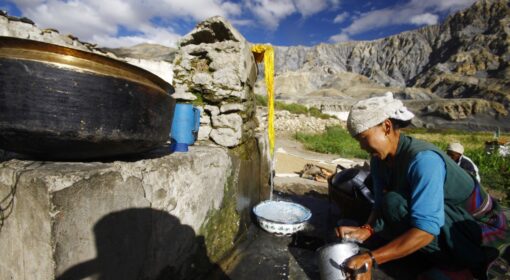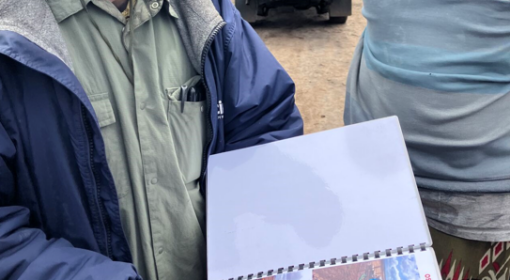by Atikah Eria Putri and Long Hoang
Introduction
Water is essential for humans’ lives as well as the ecosystem’s health. It does not only provide well-being for societies but also food, jobs, and economic activities – all key elements of what is often referred to as the blue economy – the economy of water. However, precious water resources have become the forefront of the global climate crisis, where most climate change impacts are felt in the water systems. Moreover, there are more than two billion people currently lack access to safe water and basic sanitation[1]. These conditions lead to urgent demands for blue finance – an emerging cluster of financial investments focusing on sustainable water management and ocean conservation. In recent years, the global investment into blue finance and the blue economy has been increasing rapidly, and this is expected to grow further in views of the significant financing gap for meeting the water-related SDGs[2]. Current estimates shows that the blue SDGs takes about 20% of the total SDG financing gap of USD 4 trillion per year
Together with increasing investment and projected growth, interests in blue financing and blue economy have grown considerably. Since 2018, 18 guidelines, principles, and frameworks for blue and green finance have been released by the European Commission, IFC, ICMA, UN, ADB, LMA, LSTA, and APLMA. This article aims to provide an overview and in-depth understanding of what investment activities are considered blue financing. We do this by systematically analyzing 18 existing prominent guidelines (Table 1).
The 18 Guidelines, Principles, and Frameworks of Green and Blue Finance
In Table 1 we present an overview of the prominent guidelines, frameworks, and principles related to blue and green finance. A few observations are worth noting. The earliest document was issued starting in 2018 and notably, most of the documents, especially those for blue finance, were published after 2021. This directly suggests that the field is new and still under development. Out of 18 documents, only eight involved the blue economy activities. In contrast, the others focused on green finance, sustainability bonds, or the principles of blue finance without specifying the eligible activities to be considered “blue.” Lastly, the guidelines and frameworks were released by a wide range of organizations from banks (ADB) to inter-governmental organizations (UN), etc., suggesting interest from relatively diverse groups.
Table 1 The Comprehensive of the 18 Guidelines, Principles, and Frameworks of Blue and Green Finance
| No | Issuer | Title | Link | Release | Focus |
| 1 | European Commission | European Green Bond Standard | keep reading here | Oct-2023 | The regulation of Green Bonds and Green Economy in the EU |
| 2 | IFC/ICMA/UN/ADB | Bonds to Finance the Sustainable Blue Economy: A Practitioner’s Guide | keep reading here | Sep-2023 | The key components and projects that can be funded by blue bonds |
| 3 | European Commission | EU Taxonomy for Sustainable Activities | keep reading here | Jun-2023 | Transitioning finance into environment-friendly finance in the long term (green finance) by focusing on 6 aspects (Climate Delegated Act and Environmental Delegated Act) |
| 4 | Loan Market Association (LMA) / Loan Syndications and Trading Association (LSTA) / The Asia Pacific Loan Market Association (APLMA) | Guidance on Green Loan Principles | keep reading here | Apr-2023 | The detailed explanation of the Green Loan Principle (GLP) in Q&A format |
| 5 | LMA/LSTA/APLMA | Guidance on Sustainability Linked Loan Principles (SLLP) | keep reading here | Feb-2023 | A detailed explanation of Sustainability-Linked loan principles in Q&A format |
| 6 | IFC | Guidelines for Blue Finance | keep reading here | Jan-2022 | Blue finance for ocean and water resources |
| 7 | ADB | Sovereign Blue Bonds: Quick Start Guide | keep reading here | Sep-2021 | Focus on the application of a blue bond and which programs can be funded by a blue bond. |
| 8 | ICMA | Sustainability Bond Guidelines | keep reading here | Jun-2021 | The principle of sustainability bond for green and social projects |
| 9 | UN | Turning the Tide: How to Finance a Sustainable Ocean Recovery | keep reading here | Mar-2021 | Practical guidelines for financial institutions to support the transition to a sustainable blue economy
|
| 10 | UN | Practical Guidance to Issue a Blue Bond | keep reading here | 2020 | Step by step to issue the blue bond |
| 11 | LMA/LSTA/APLMA | Sustainability-Linked Loan Principles | keep reading here | Feb-2023 | The explanation of the five core components of the sustainability-linked loan principle |
| 12 | ICMA | Sustainability Linked Bond Principles | keep reading here | Jun-2023 | The principle of implementing sustainability-linked bond |
| 13 | ADB | Green and Blue Bonds Framework | keep reading here | Sep-2021 | The framework of green and blue finance |
| 14 | IFC | Green Bond Principles | keep reading here | Jun-2021 | The principle of green bonds, the projects that are supported by green bonds, and the core of it |
| 15 | LMA/LSTA/APLMA | Green Loan Principles | keep reading here | Feb-2023 | The definition of green loans and the explanation of the four core green loan principles |
| 16 | UN | Sustainable Blue Economy Finance Principles | keep reading here | Mar-2018 | The 14 principles when financing the blue economy |
| 17 | European Investment Bank (EIB) | Sustainability Criteria for the Blue Economy: Main Report | keep reading here | Mar-2021 | The development of a Blue Economy Sustainability Framework to guide sustainable practices for blue economy, integrating environmental, social, economic, and governance dimensions to promote blue economy, informed investment, and policymaking. |
| 18 | European Investment Bank (EIB) | Clean oceans and the blue economy: Overview | keep reading here | Apr-2024 | Emphasize the need for clean oceans and sustainable blue economy practice, highlighting the EIB’s role in financing decarbonization, renewable energy, and innovation to address pollution, climate change, and overfishing. |
Here, we also attempt to conceptualize the relationships between blue finance, and several interrelated financing mechanisms based on the current guidelines. Blue finance, green finance, and climate finance together form a framework for mobilizing capital to address environmental, social, and governance (ESG) challenges while fostering economic growth, all belonging to the umbrella concept of sustainable finance.
- Sustainable finance: Encompasses all financial activities that integrate environmental, social, and governance (ESG) considerations into decision-making, aiming for long-term sustainable

The diagram of sustainable finance, green finance, climate finance, and blue finance (source European Investment Bank) outcomes.
- Green finance: A subset of sustainable finance, dedicated to financing projects that have positive environmental impacts, such as conserving biodiversity, reducing pollution, and supporting renewable energy.
- Blue finance: A subset of green finance, focusing on financing sustainable use and conservation of ocean and water resources.[3]
- Climate Finance: A subset of green finance, focusing on financing activities aimed at mitigating or adapting to climate change impacts.
- Green finance: A subset of sustainable finance, dedicated to financing projects that have positive environmental impacts, such as conserving biodiversity, reducing pollution, and supporting renewable energy.
The Activities that are Considered as Blue Finance
Reviewing the ten prominent guidelines on blue economy and blue finance, we identified a total of 25 activities which are considered blue finance. As can be seen from Table 2-4, there is remarkable differences amongst the guidelines in terms of what is categorized as blue finance. This suggests that the taxonomy of blue economy and blue finance is still underdeveloped, where there is no general consensus on what constitutes a blue investment. Several activities show a stronger consensus as they are regarded as blue, including Sustainable marine value chains; Marine Ecosystem Management, Conservation, and Restoration; Marine Renewable Energy; Sustainable Shipping and Ports Logistic Sectors; Water Sanitation. On the other hand, some activities showing divergent classification include water supply; sustainable tourism services; marine pollution; sustainable marine transport; and Ocean-Friendly and Water-Friendly Product.
Table 2 Taxonomy of blue financing activities according to 10 prominent guidelines
| No | Activity | IFC/ICMA/ UN/ADB | IFC | ADB | UN | UN | ADB | IFC | LMA/LSTA/ APLMA | EIB |
| Bonds to Finance the Sustainable Blue Economy: A Practitioner’s Guide | Guidelines for Blue Finance | Sovereign Blue Bonds: Quick Start Guide | Turning the Tide: How to Finance a Sustainable Ocean Recovery | Practical Guidance to Issue a Blue Bond | Green and Blue Bonds Framework | Green Bond Principles | Green Loan Principles | Clean oceans and the blue economy: Overview | ||
| 1 | Coastal Climate Adaptation and Resilience | ✓ | ✓ | |||||||
| 2 | Marine Ecosystem Management, Conservation, And Restoration | ✓ | ✓ | ✓ | ✓ | ✓ | ✓ | |||
| 3 | Sustainable Marine (Fisheries, Aquaculture, And Seafood) Value Chains | ✓ | ✓ | ✓ | ✓ | ✓ | ✓ | ✓ | ✓ | ✓ |
| 4 | Marine Renewable Energy | ✓ | ✓ | ✓ | ✓ | ✓ | ✓ | ✓ | ||
| 5 | Marine Pollution | ✓ | ✓ | ✓ | ✓ | |||||
| 6 | Sustainable Shipping And Ports Logistic Sectors | ✓ | ✓ | ✓ | ✓ | ✓ | ✓ | ✓ | ||
| 7 | Sustainable Marine Transport | ✓ | ✓ | ✓ | ||||||
| 8 | Water Supply | ✓ | ✓ | ✓ | ✓ | ✓ | ✓ | |||
| 9 | Water Sanitation | ✓ | ✓ | ✓ | ✓ | ✓ | ✓ | ✓ |
Table 3 Taxonomy of blue financing activities according to 10 prominent guidelines
| No | Activity | IFC/ICMA/ UN/ADB | IFC | ADB | UN | UN | ADB | IFC | LMA/LSTA/ APLMA | EIB |
| Bonds to Finance the Sustainable Blue Economy: A Practitioner’s Guide | Guidelines for Blue Finance | Sovereign Blue Bonds: Quick Start Guide | Turning the Tide: How to Finance a Sustainable Ocean Recovery | Practical Guidance to Issue a Blue Bond | Green and Blue Bonds Framework | Green Bond Principles | Green Loan Principles | Clean oceans and the blue economy: Overview | ||
| 10 | Ocean-Friendly And Water-Friendly Product | ✓ | ||||||||
| 11 | Sustainable Tourism Services | ✓ | ✓ | ✓ | ✓ | |||||
| 12 | Ocean-Draining River Rehabilitation | ✓ | ||||||||
| 13 | Solid Waste Management And Circular Economy | ✓ | ✓ | ✓ | ||||||
| 14 | Ocean Data, Biodiversity, Marine Minerals, Seaweed | ✓ | ||||||||
| 15 | Energy Efficiency | ✓ | ✓ | ✓ | ||||||
| 16 | Sustainable Transport | ✓ | ✓ | ✓ | ||||||
| 17 | Energy Infrastructure Resilience | ✓ | ||||||||
| 18 | Agriculture | ✓ |
Table 4 Taxonomy of blue financing activities according to 10 prominent guidelines
| No | Activity | IFC/ICMA/ UN/ADB | IFC | ADB | UN | UN | ADB | IFC | LMA/LSTA/ APLMA | EIB |
| Bonds to Finance the Sustainable Blue Economy: A Practitioner’s Guide | Guidelines for Blue Finance | Sovereign Blue Bonds: Quick Start Guide | Turning the Tide: How to Finance a Sustainable Ocean Recovery | Practical Guidance to Issue a Blue Bond | Green and Blue Bonds Framework | Green Bond Principles | Green Loan Principles | Clean oceans and the blue economy: Overview | ||
| 19 | Renewable Energy | ✓ | ✓ | |||||||
| 20 | Pollution Prevention And Control | ✓ | ✓ | |||||||
| 21 | Environmentally Sustainable Management Of Living Natural Resources And Land Use | ✓ | ✓ | |||||||
| 22 | Climate Change Adaptation | ✓ | ✓ | |||||||
| 23 | Circular Economy Adapted Products, Production Technologies And Processes | ✓ | ✓ | |||||||
| 24 | Green Buildings | ✓ | ✓ | |||||||
| 25 | Ocean-Related Research And Innovation | ✓ |
Conclusion
Blue finance is an emerging concept that can be utilized to address water-related pressing issues. It embodies a targeted investment focusing on sustainable water management and ocean preservation, which are essential to promote the blue economy and achieve the water-related Sustainable Development Goals (SDGs). Although the concept is relatively new, as shown by the emergence of frameworks and guidelines since 2018, it is rapidly gaining momentum. There are many activities that exemplify the scope of blue finance, ranging from renewable energy from the marine ecosystems to the water supply.
The taxonomy of blue finance remains under-established, with varying definitions across organizations and international financial institutions (IFIs). Recently, an increasing number of guidelines and frameworks for blue finance have been released, amongst which the IFC guideline (2022) is a predominant guiding framework (Figure 1). While the overarching goal is to support sustainable ocean and water resource management, there is currently no universal agreement on what constitutes “blue” investments. For example, some entities include coastal infrastructure, renewable energy, and sustainable fisheries, while others emphasize ocean-based climate mitigation (e.g., blue carbon ecosystems). Another example is with inland water resources (water supply and sanitation), where financing for such systems are sometimes considered blue investments (according to the IFC blue finance guideline[4]), and sometimes not listed under blue financing activities (for instance according to joint practitioner’s guide for Bonds to Finance the Sustainable Blue Economy jointly published by ADB, IFC, ICMA, and UNEP[5]. This lack of standardization complicates efforts to mobilize and track capital flows. The divergence stems from differing priorities, regional contexts, and organizational mandates. A harmonized taxonomy is therefore crucial for ensuring transparency, scalability, and impact in blue finance investments[6].
[1] There are still around 2 billion people around the world without access to safely managed drinking water services https://blogs.worldbank.org/en/opendata/world-water-day-two-billion-people-still-lack-access-safely-managed-water
[2] https://www.rabobank.com/knowledge/d011423183-blue-finance-closing-the-water-financing-gapmber
[3] Also note that sometimes blue finance is considered a subset of climate finance (e.g. by the IFC Blue finance guideline https://www.ifc.org/en/insights-reports/2022/guidelines-for-blue-finance
[4] https://www.ifc.org/en/insights-reports/2022/guidelines-for-blue-finance
[5] https://www.adb.org/publications/bonds-finance-sustainable-blue-economy-practitioners-guide
[6] Nobel, A. (2024, April 15). Blue finance: Closing the water financing gap. Rabobank. Retrieved from https://www.rabobank.com/knowledge/d011423183-blue-finance-closing-the-water-financing-gap




